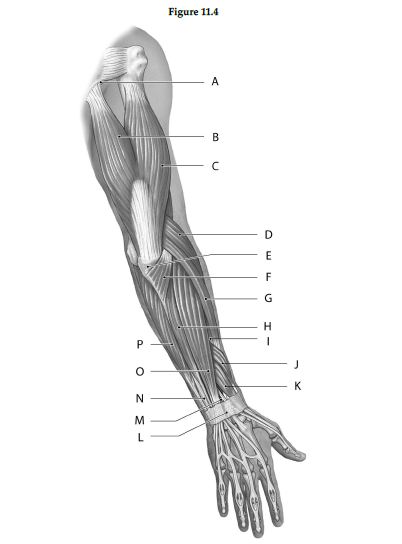Using the figure below, identify the labeled part.

1) Label A: ______________________________
2) Label B: ______________________________
3) Label C: ______________________________
4) Label D: ______________________________
5) Label E: ______________________________
6) Label F: ______________________________
7) Label G: ______________________________
8) Label H: ______________________________
9) Label I: ______________________________
10) Label J: ______________________________
11) Label K: ______________________________
12) Label L: ______________________________
13) Label M: ______________________________
14) Label N: ______________________________
15) Label O: ______________________________
16) Label P: ______________________________
1) Infraglenoid tubercle of scapula
2) Triceps brachii, long head
3) Triceps brachii, lateral head
4) Brachioradialis
5) Olecranon of ulna
6) Anconeus
7) Extensor carpi radialis longus
8) Extensor carpi ulnaris
9) Extensor carpi radialis brevis
10) Abductor pollicis longus
11) Extensor pollicis brevis
12) Extensor retinaculum
13) Radius
14) Ulna
15) Extensor digitorum
16) Flexor carpi ulnaris
You might also like to view...
In general, polar molecules diffuse more rapidly across cell membranes than do nonpolar molecules.
Answer the following statement true (T) or false (F)
A person who is acclimated to a hot environment will begin to react physiologically to a decreased environmental temperature faster than a person who is not.
Answer the following statement true (T) or false (F)
The tissues turning yellow (jaundice) is due to the accumulation of
A. cholesterol. B. hemoglobin A. C. bile pigments. D. carotene.
Label A represents which of the following structures?

A) hilum
B) renal pelvis
C) renal cortex
D) renal medulla
E) renal sinus